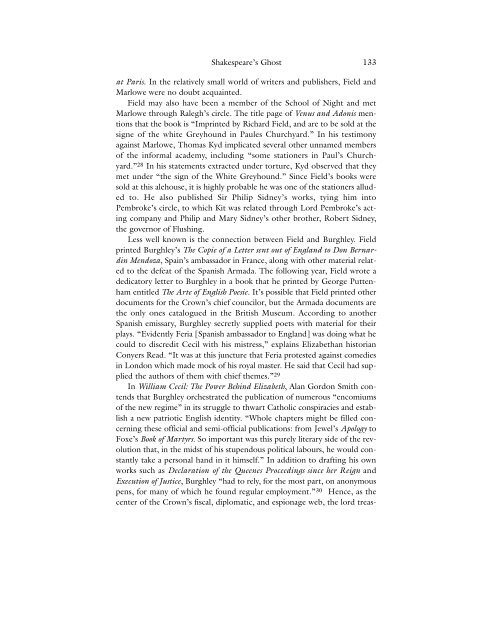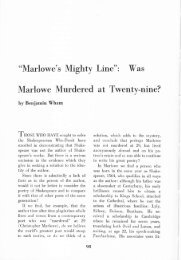Page 113-180 Shakespeare - The Marlowe Studies
Page 113-180 Shakespeare - The Marlowe Studies
Page 113-180 Shakespeare - The Marlowe Studies
You also want an ePaper? Increase the reach of your titles
YUMPU automatically turns print PDFs into web optimized ePapers that Google loves.
<strong>Shakespeare</strong>’s Ghost 133at Paris. In the relatively small world of writers and publishers, Field and<strong>Marlowe</strong> were no doubt acquainted.Field may also have been a member of the School of Night and met<strong>Marlowe</strong> through Ralegh’s circle. <strong>The</strong> title page of Venus and Adonis mentionsthat the book is “Imprinted by Richard Field, and are to be sold at thesigne of the white Greyhound in Paules Churchyard.” In his testimonyagainst <strong>Marlowe</strong>, Thomas Kyd implicated several other unnamed membersof the informal academy, including “some stationers in Paul’s Churchyard.”28 In his statements extracted under torture, Kyd observed that theymet under “the sign of the White Greyhound.” Since Field’s books weresold at this alehouse, it is highly probable he was one of the stationers alludedto. He also published Sir Philip Sidney’s works, tying him intoPembroke’s circle, to which Kit was related through Lord Pembroke’s actingcompany and Philip and Mary Sidney’s other brother, Robert Sidney,the governor of Flushing.Less well known is the connection between Field and Burghley. Fieldprinted Burghley’s <strong>The</strong> Copie of a Letter sent out of England to Don BernardinMendoza, Spain’s ambassador in France, along with other material relatedto the defeat of the Spanish Armada. <strong>The</strong> following year, Field wrote adedicatory letter to Burghley in a book that he printed by George Puttenhamentitled <strong>The</strong> Arte of English Poesie. It’s possible that Field printed otherdocuments for the Crown’s chief councilor, but the Armada documents arethe only ones catalogued in the British Museum. According to anotherSpanish emissary, Burghley secretly supplied poets with material for theirplays. “Evidently Feria [Spanish ambassador to England] was doing what hecould to discredit Cecil with his mistress,” explains Elizabethan historianConyers Read. “It was at this juncture that Feria protested against comediesin London which made mock of his royal master. He said that Cecil had suppliedthe authors of them with chief themes.” 29In William Cecil: <strong>The</strong> Power Behind Elizabeth, Alan Gordon Smith contendsthat Burghley orchestrated the publication of numerous “encomiumsof the new regime” in its struggle to thwart Catholic conspiracies and establisha new patriotic English identity. “Whole chapters might be filled concerningthese official and semi-official publications: from Jewel’s Apology toFoxe’s Book of Martyrs. So important was this purely literary side of the revolutionthat, in the midst of his stupendous political labours, he would constantlytake a personal hand in it himself.” In addition to drafting his ownworks such as Declaration of the Queenes Proceedings since her Reign andExecution of Justice, Burghley “had to rely, for the most part, on anonymouspens, for many of which he found regular employment.” 30 Hence, as thecenter of the Crown’s fiscal, diplomatic, and espionage web, the lord treas-






